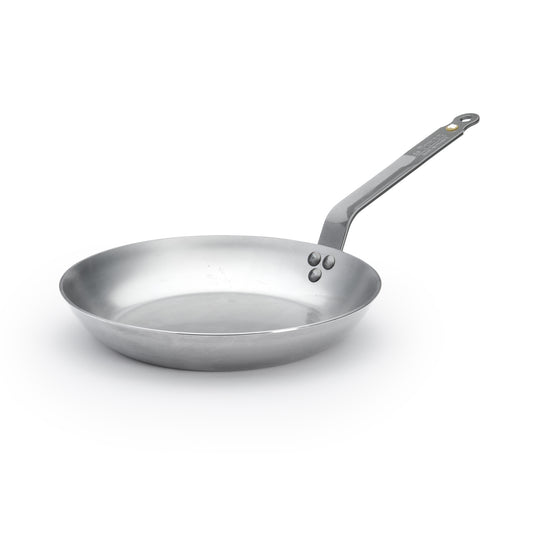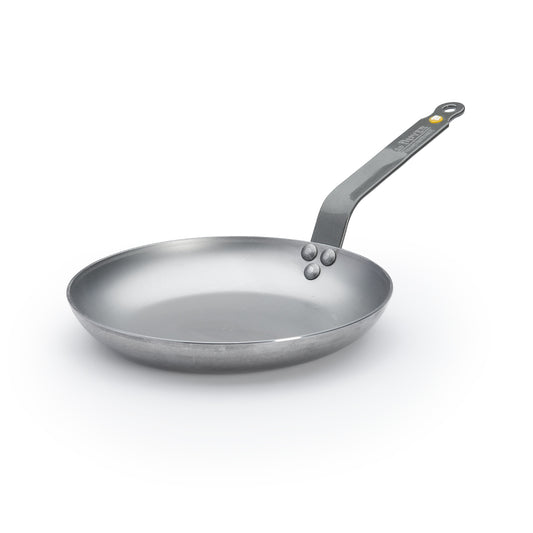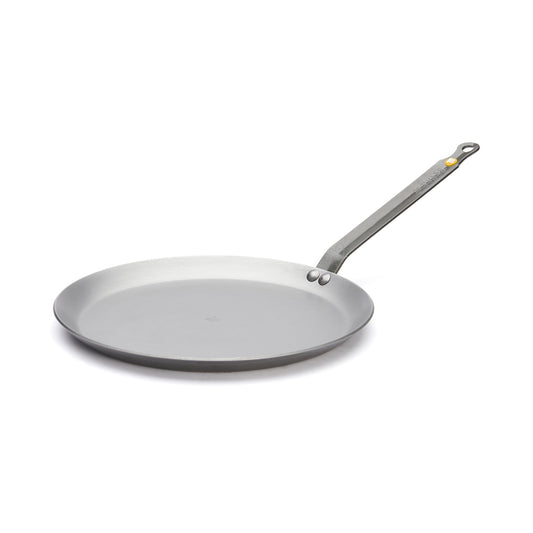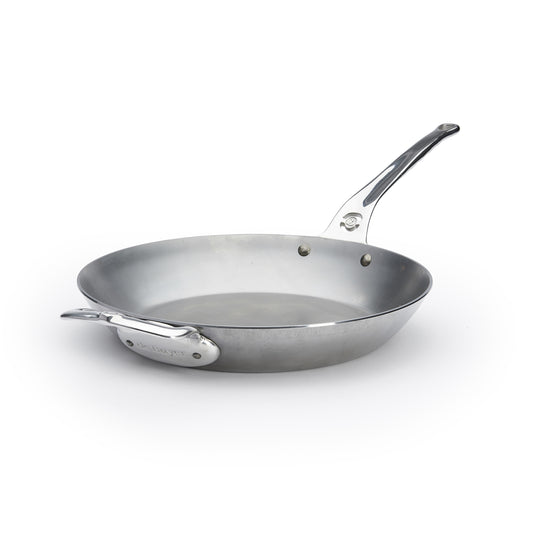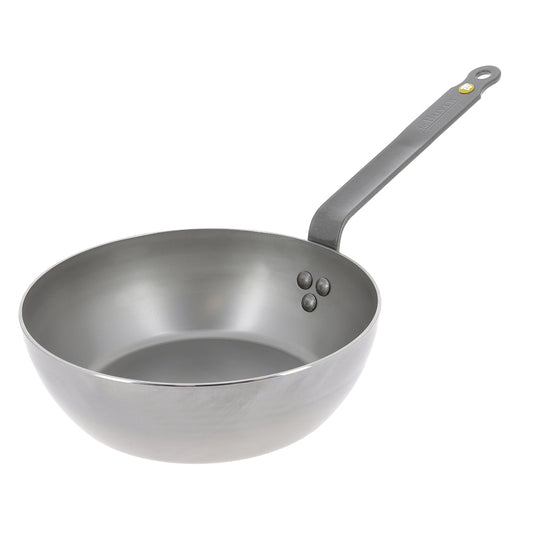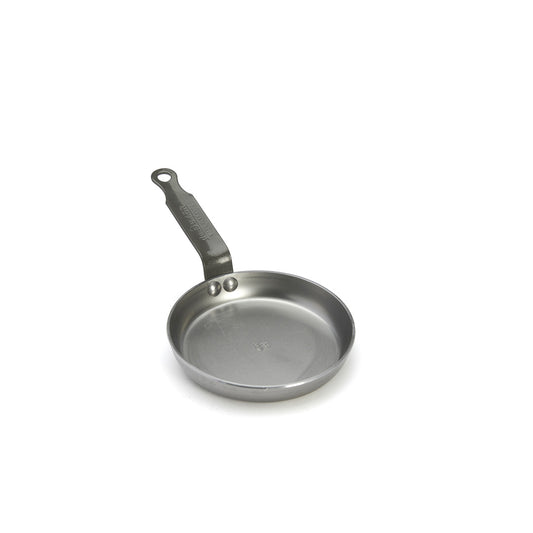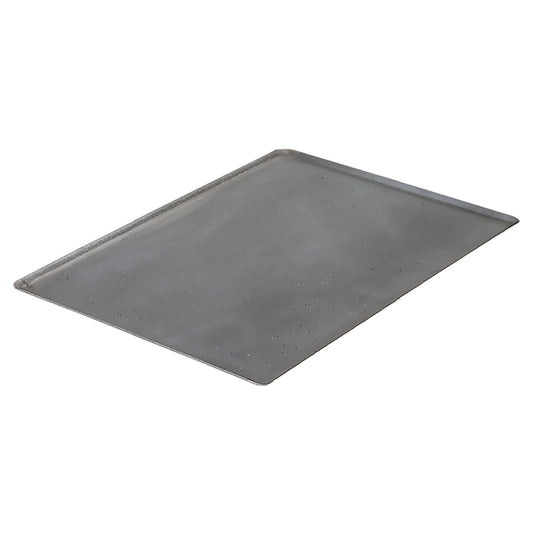Griddle vs. Grill: Which is Right for Your Cooking Style?
Griddle vs grill: which suits your cooking style best? Learn the key differences in heat, flavor, and versatility to find the ideal match for your kitchen.
de Buyer

Grills and griddles are excellent tools for cooking anything from burgers to steaks to corn. Choosing between the two requires in-depth knowledge of cooking appliances and an understanding of your own needs and preferences.
de Buyer is a brand that understands the nuances of cookery and offers high-quality solutions and insights for various culinary needs. In this article, we’ll explore the differences between griddles and grills, helping you choose the best option for your cooking preferences.
The Griddle: Flat-Top Mastery
A griddle is a specialty cooking tool with a flat cooking surface, often with a low lip. The smooth, flat top griddle surface encourages an even heat distribution. There are several different types of griddles, including:
- Electric Griddle: Electric griddles have built-in heating elements and plug into an outlet. They're great for cooking outdoors (if you have electricity) without a fire but require ample counter space.
- Outdoor Gas Griddle: These griddles are the largest option. They are powered by gas and function similarly to a grill.
- Griddle Pan (or stovetop griddle): These are a no-fuss, space-saving option that sits directly on your stove or over a campfire and doesn't require an outlet. They're the easiest griddle to store.
All griddles allow you to cook many items at one time which makes it easy to prepare foods like pancakes, eggs, bacon, sandwiches, and smash burgers. Griddle pans can also cook delicate items without breaking them. For example, fish and finely chopped veggies are easy to prepare on a griddle, and the consistent browning is superior.
Advantages of Using a Griddle Pan
- Even cooking and consistent results.
- Ideal for cooking large quantities of food.
- Versatility for various breakfast, lunch, and dinner items.
- Easy to use in small spaces or without access to the outdoors.
The Grill: Sear and Smoke
A grill is an outdoor cooking tool with raised grates positioned above an open heat source. Depending on the grill type, this heat can come from gas, charcoal, or electricity. These grates create char marks, and when the grill top is closed, the hot environment creates unique smoky flavors. These grills are typically large and challenging to maneuver into different positions.
Different types of grills impart different flavors and require different techniques to master. For example, using a charcoal grill requires precisely arranging the coals based on your desired temperature and cooking time.
Since food is placed directly on the grill grate, these tools are especially well-suited for cooking anything with excess fats like some meats and poultry. Firm fish, seafood, and hearty vegetables like squash also work well on the grill. The unique sear or char from this tool creates the distinctive marks that the grill is known for.
Advantages of Using a Grill
- Creates char marks and smoky flavors.
- Allows for fat to drip away, resulting in leaner cooking.
- Ideal for smoking and high-heat cooking.
Griddle vs. Grill: The Core Differences
Now, we’ll explore the core difference between a traditional grill and a griddle.
Surface and Distribution
The flat surface of a griddle is a completely different cooking vehicle from the raised grates of a grill. A grill distributes heat unevenly between the metal grades and open space via radiation and conduction. Radiation helps cook the food by transferring heat from the direct flame below, while convection is the primary cooking method when food touches the hot grates directly.
Many grills have separate burners with their own control knob, letting you adjust the temperature in different areas. This allows you to create heat zones, for instance, high heat on one side for searing and lower heat on the other for gentle, even cooking. Despite the inherent heat distribution differences, this setup allows a little more control.
Meanwhile, if used correctly, a griddle does not have this problem. The completely flat metal surface cooks via convection. A high-quality carbon steel griddle heats evenly and quickly giving the cook a more precise control over heat and cook time. The griddle does not have separate zones for different cooking temperatures.
Cooking Techniques and Outcomes
The benefits of the griddle's heat distribution perks are even browning across all foods. Alternatively, the grill creates char marks and a distinct smokey flavor. These two cooking methods are an example of an all-around cooking vehicle and a more niche cooking method.
From a gas grill to a pellet grill, the flavor profile and distinctive char will be the same. You can cook bratwurst or corn on a grill, and the base profile will be exactly the same. Alternatively, a flat griddle can cook distinct and flavorful French toast, bacon, or mushrooms at the same time. Any food prepared on a griddle will maintain its unique flavor signature.
Food Types and Versatility
The cooking outcome and design of grills mean that you should not use them to cook the following foods.
- Delicate Fish
- Thinly Sliced Veggies/Proteins
- Foods with Excess Marinade
- Any Runny Food
-
Smash Burgers
However, foods like steaks, ribs, tuna steaks, naan, and caramelized pineapple are exceptional when grilled. These foods can also be prepared on a griddle if you prefer them without the distinctive char crunch and the smokey flavor.
A griddle can cook nearly anything. It’s best used to cook food quickly and efficiently. Anything from stir fry to grilled sandwiches to fried eggs will taste delicious hot from the griddle. A griddle is also simple to clean. It’s best to hand wash with gentle soap and sponges. Anything too harsh will strip the seasoning.
Cleaning a grill is a more intensive process.
- Heat It Up: Turn on your gas grill and close the lid for 15 minutes to burn off grease. For charcoal grills, discard old briquettes and scrape away residue. Remove grates, trays, and knobs.
- Cool It Down: Turn off the grill and let it fully cool. Disconnect the propane tank if using gas.
- Spray and Soak: Spray grill grates evenly with grill cleaner, letting the suds sit for 5–10 minutes to break down the grime.
- Scrub and Rinse: Scrub grates with a bristle-free or nylon brush. Rinse well, then let air dry.
- Reassemble and Heat: Once dry, reassemble your grill and reconnect the propane tank. Fire it up for 20 minutes with the lid closed to burn off any leftover residue and ensure it’s ready to go.
Choosing the Right Cooking Surface for Your Needs
Ask yourself the following questions before choosing between a grill and a griddle.
- Consider your cooking style: Do you prefer even cooking and consistent results or char marks and smoky flavors? Do you frequently cook breakfast items or large quantities of food?
- Consider your dietary preferences: Do you prefer leaner cooking or enjoy the flavor of rendered fat?
- Consider your available space and equipment: Do you have a dedicated outdoor grill or limited kitchen space?
- Consider the weather and preference: Do you prefer cooking indoors or outdoors? How many months of the year can you easily cook outdoors?
Your Culinary Choice: Griddle or Grill?
It’s important to consider your cooking needs and preferences when making a decision. Grills are large and nearly immovable from their outdoor location but offer superior smoking. Griddles are transportable and convenient. They heat evenly and quickly and offer superior heat distribution. Your decision should reflect your personal preferences and needs.
de Buyer offers high-quality options for both griddle and a version of grill cooking. Grilling with our carbon steel pans creates the perfect sear every time, whether indoors or outside: stove, grill, BBQ, or open fire. Our carbon steel griddle is an indispensable tool that only becomes more non-stick over time.
Choose the cooking method that best aligns with your cooking space and personal preferences.
Learn More
Recommended for You
-
MINERAL B PRO Carbon Steel Fry Pan
Regular price $90.00Regular priceUnit price / per$0.00Sale price $90.00 -
MINERAL B Classic Carbon Steel Fry Pan
Regular price $60.00Regular priceUnit price / per -
MINERAL B Carbon Steel Omelette Pan
Regular price $65.00Regular priceUnit price / per -
MINERAL B PRO Carbon Steel Omelette Pan
Regular price $105.00Regular priceUnit price / per -
Protective Sleeve for Pan Handle
Regular price $9.95Regular priceUnit price / per -
MINERAL B Carbon Steel Crepe & Tortilla Pan
Regular price $70.00Regular priceUnit price / per -
MINERAL B PRO Carbon Steel Fry Pan with Helper Handle
Regular price $145.00Regular priceUnit price / per -
Blue Carbon Steel Fry Pan
Regular price $45.00Regular priceUnit price / per -
Blue Carbon Steel Crepe & Tortilla Pan
Regular price $25.00Regular priceUnit price / per -
MINERAL B Carbon Steel Country Fry Pan
Regular price $100.00Regular priceUnit price / per -
MINERAL B Carbon Steel Egg & Pancake Pan
Regular price $35.00Regular priceUnit price / per -
Blue Carbon Steel Rectangular Baking Sheet
Regular price $35.00Regular priceUnit price / per












